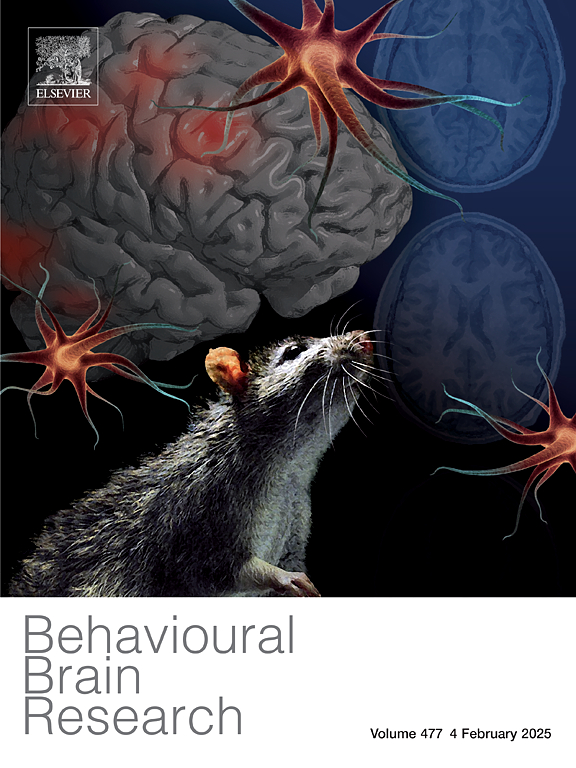Vulnerability to chronic stress in male rats: Additive effect of low positive affectivity and high hedonic response as measured by sucrose intake
IF 2.3
3区 心理学
Q2 BEHAVIORAL SCIENCES
引用次数: 0
Abstract
Stress contributes to the development of psychiatric disorders. We have previously shown that rats with low inherent positive affectivity, assessed by 50-kHz ultrasonic vocalizations (USV), are more vulnerable to stress, and that free-fed rats with persistently lower consumption of sucrose are less sensitive. Hence we compared the association of these traits with the effect of chronic stress within a single experiment. Male Wistar rats were classified as of high (HC) or low (LC) positive affectivity based on their average 50-kHz USV response, and as young adults the rats were further divided into high and low sucrose-consuming (HSuc and LSuc, respectively). Four groups comprising twenty rats each were formed, and half of the animals submitted to chronic variable stress (CVS) for 5 weeks. CVS was followed by behavioural tests and ex vivo biochemical analyses. In elevated plus-maze, CVS increased the anxiety-related measures most prominently in the LC-HSuc rats. Stress reduced amphetamine-induced 50-kHz USVs statistically significantly only in LC-HSuc rats. Serum glucose and adrenal weight, as well as levels of monoamines and their metabolites in the frontal cortex, striatum, nucleus accumbens, amygdala and hypothalamus, were altered by chronic stress mostly in a phenotype-dependent manner. CVS also increased 5-HT2 C-receptor gene expression in the striatum of LC-HSuc rats. Conclusively, previous separate findings that individual differences in positive affectivity and sucrose intake (hedonic response) can contribute to stress vulnerability were confirmed. Importantly, the highest vulnerability to stress was found if low positive affectivity and high sucrose consumption coincided.
雄性大鼠对慢性应激的脆弱性:低积极情感和高享乐反应的叠加效应,通过蔗糖摄入量来测量
压力会导致精神疾病的发展。我们之前的研究表明,通过50 khz超声发声(USV)评估,具有低内在积极情感的大鼠更容易受到压力的影响,而持续减少蔗糖消耗的自由喂养大鼠则不那么敏感。因此,我们在一个单一的实验中比较了这些特征与慢性压力的影响之间的关系。根据雄性Wistar大鼠的平均50 khz USV反应,将其分为高(HC)和低(LC)正向情感,并将其作为年轻成年大鼠进一步分为高和低蔗糖消耗(分别为HSuc和LSuc)。将大鼠分成4组,每组20只,其中一半进行5周的慢性可变应激(CVS)。CVS之后进行行为测试和离体生化分析。在升高的+迷宫中,CVS在LC-HSuc大鼠中最显著地增加了焦虑相关指标。应激降低安非他明诱导的50 khz USVs仅在LC-HSuc大鼠中有统计学意义。血清葡萄糖和肾上腺重量,以及额叶皮质、纹状体、伏隔核、杏仁核和下丘脑中单胺及其代谢物的水平,在慢性应激下大多以表型依赖的方式发生改变。CVS还增加了LC-HSuc大鼠纹状体中5-HT2 c受体基因的表达。最后,先前单独的研究结果证实,积极情感和蔗糖摄入(享乐反应)的个体差异可能导致压力易感性。重要的是,如果低积极情绪和高蔗糖消耗同时发生,那么对压力的脆弱性最高。
本文章由计算机程序翻译,如有差异,请以英文原文为准。
求助全文
约1分钟内获得全文
求助全文
来源期刊

Behavioural Brain Research
医学-行为科学
CiteScore
5.60
自引率
0.00%
发文量
383
审稿时长
61 days
期刊介绍:
Behavioural Brain Research is an international, interdisciplinary journal dedicated to the publication of articles in the field of behavioural neuroscience, broadly defined. Contributions from the entire range of disciplines that comprise the neurosciences, behavioural sciences or cognitive sciences are appropriate, as long as the goal is to delineate the neural mechanisms underlying behaviour. Thus, studies may range from neurophysiological, neuroanatomical, neurochemical or neuropharmacological analysis of brain-behaviour relations, including the use of molecular genetic or behavioural genetic approaches, to studies that involve the use of brain imaging techniques, to neuroethological studies. Reports of original research, of major methodological advances, or of novel conceptual approaches are all encouraged. The journal will also consider critical reviews on selected topics.
 求助内容:
求助内容: 应助结果提醒方式:
应助结果提醒方式:


